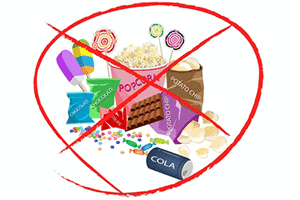 At Carrington College we want our students to set a good example to your friends, family and future patients when it comes to your health and well being, and that includes knowing about good nutrition. It’s shocking to know that the following common ingredients in our food* are actually banned in other parts of the world. It should be said that much of the research into this is inconclusive at best, but it should still make you stop and think about how much packaged or processed food you eat every day. And whether you really know what’s in it! Do your research, and always read nutrition labels closely, and where possible prepare your food fresh!
At Carrington College we want our students to set a good example to your friends, family and future patients when it comes to your health and well being, and that includes knowing about good nutrition. It’s shocking to know that the following common ingredients in our food* are actually banned in other parts of the world. It should be said that much of the research into this is inconclusive at best, but it should still make you stop and think about how much packaged or processed food you eat every day. And whether you really know what’s in it! Do your research, and always read nutrition labels closely, and where possible prepare your food fresh!
- Artificial Food DyeIt might make your food look more appetizing, but don’t be fooled. Found in everything from cake mixes, to sports drinks, cheese, candy, and even Mac & Cheese, artificial dyes are made from chemicals derived from crude oil! Artificial dye has been linked to brain cancer, nerve-cell deterioration, and hyperactivity in children, just to name a few.They’re banned in Norway, Finland, Austria, France, & the U.K.
- Olestra (or Olean) Found in fat-free potato chips, corn chips, and French fries, this substitute for cooking oil may lower the calorie count, but it robs your body of its ability to absorb vitamins, which can lead to cramps and other more unpleasant side-effects.It’s banned in the U.K. and Canada.
- Brominated Vegetable OilFound in some sports drinks and citrus-flavored sodas, this stuff makes food dye stick to liquid, giving them their bright colors. Bromine is a chemical used to stop carpets from catching on fire, so you can see why drinking it may not be the best idea. BVO is linked to major organ system damage, birth defects, growth problems, schizophrenia, and hearing loss.It’s banned in over 100 countries.
- Potassium bromate (or bromated flour)Found in wraps, rolls, bread crumbs, bagel chips, flat breads, this ‘ingredient’ is derived from the same harmful chemical as BVO above. It’s used to decrease baking time and reduce costs. It’s linked to kidney damage, cancer, and nervous system damage.It’s banned in Europe, Canada, and China.
- AzodicarbonamideFound in breads, frozen dinners, boxed pasta mixes, and packaged baked goods, this has been generally recognized as safe in the U.S. and is allowed to be added to flour. In the U.K. it has been identified as a respiratory sensitizer and a possible cause of asthma. Products including it are labeled with “May cause sensitization by inhalation”.It’s banned completely in Australia and Europe.
- BHA & BHTFound in cereal, nut mixes, gum, butter, meat, dehydrated potatoes, these food preservatives – butylated hydroxyanisole (BHA) and butylated hydroxytoluene (BHT) are known to cause cancer in rats.It’s banned in the U.K., Japan, and many European countries.
- rBGH and rBSTFound in milk and dairy products, these Synthetic growth hormones are bad for cows and people, potentially causing infertility, weakened muscle growth, and a whole array of cancers.They’re banned inAustralia, New Zealand, Canada, Japan, and the European Union (EU).
- ArsenicFound in some poultry, arsenic is used in small doses in some chicken feed to make the meat appear pinker and fresher. But arsenic is poison, which will kill you if you ingest enough.It’s banned in the EU.
* This list is taken from Rich Food, Poor Food. written by Dr. Jayson Calton & Certified Nutritionist Mira Calton and extracted from the article http://www.buzzfeed.com/ashleyperez/8-foods-we-eat-in-the-us-that-are-banned-in-other-countries
